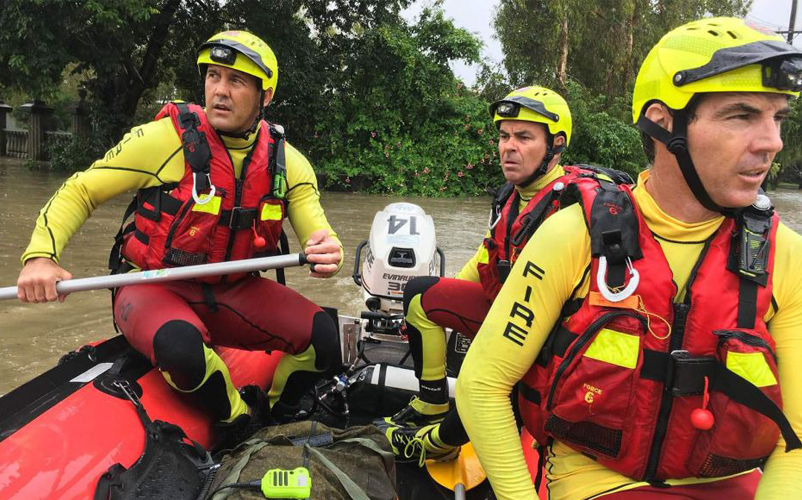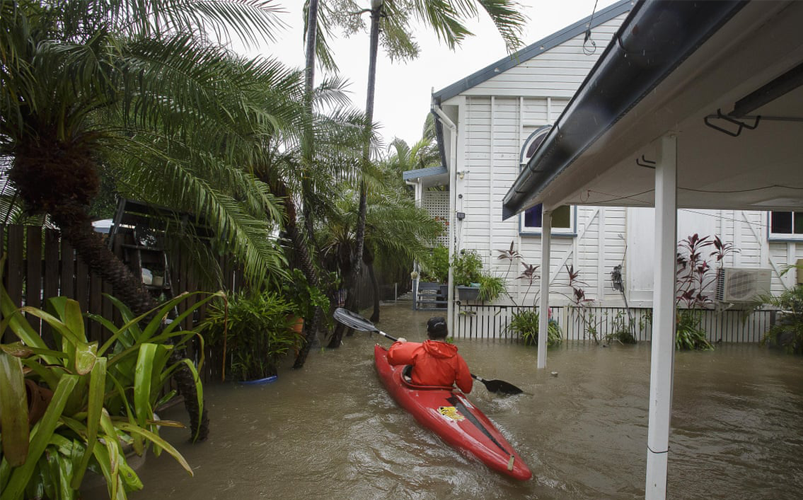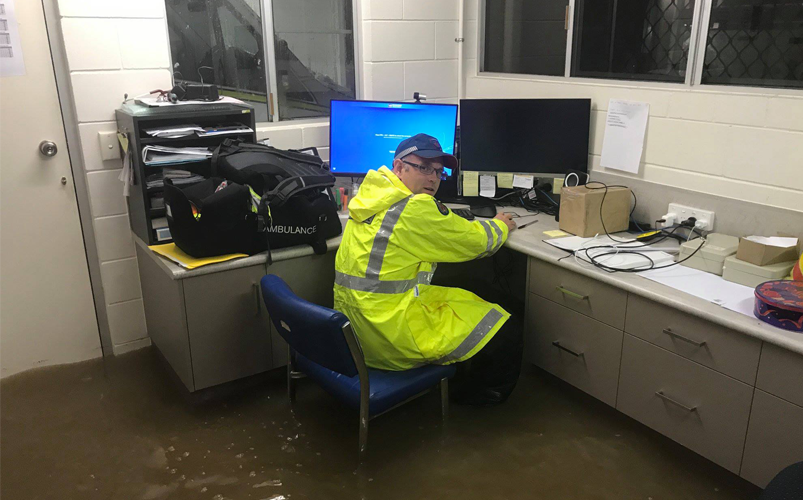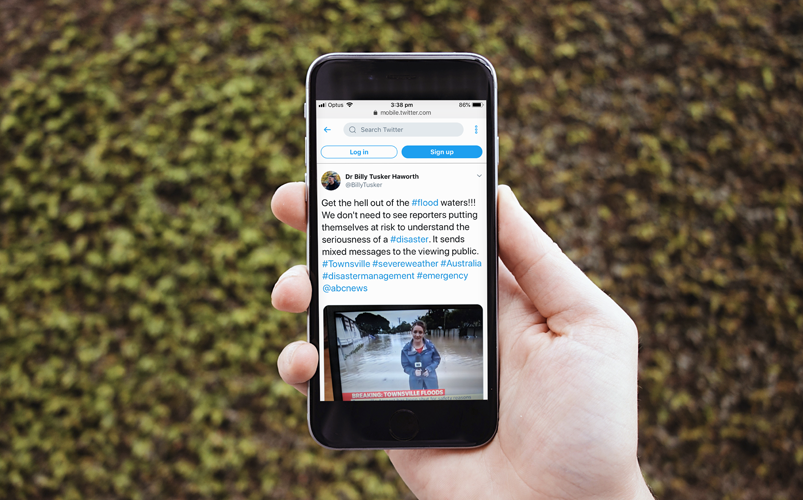Flood safety messages used extensively and consistently in Australia are ‘If it’s flooded, forget it’, ‘Never drive, ride or walk through floodwater’, ‘Don’t play in flood water’. These messages are clear, unambiguous and definitive. The problem is, people continue to enter floodwater.
In partnership with State Emergency Services across Australia, we are looking at flood risk communication and examining the two behaviours most closely linked to flood fatalities; driving into and recreating in floodwater. This is part of the Bushfire and Natural Hazards CRC Flood Risk Communication research.1

Figure 1. An assortment of images in the media and on social media that may send mixed signals to the public about entering flooded places.
To assess the problem, we started with fatality data. Our analysis of vehicle-related flood fatalities showed that 96 people died in 74 separate incidents between 2001 and 2017.2 Over that time, 51 people died recreating in floodwater3 and many of these fatalities were children or young adults. While fatality data provides the contexts and the numbers of individuals caught up in these situations, they tell us nothing about the incidence of entering floodwater generally. Why do people continue to enter floodwater against expert advice?

Figure 1. An assortment of images in the media and on social media that may send mixed signals to the public about entering flooded places.
We collected data about people entering floodwater using a nationally-representative sample of 2000 adults. Although we are still working on a detailed analysis, we found that 27 per cent of respondents had entered floodwater and 18 per cent had entered flooded rivers, either on foot (wading or swimming) or in boats (on boards or inflatables). Over half of respondents (56 per cent) reported driving through floodwater at least once, with more than half of those doing so in the last five years. More than 1100 people described recent or memorable incidents and, interestingly, in 90 per cent of cases, there was no vehicle damage or consequence of their action to drive through floodwater. So, although many people enter floodwater, and it has resulted in around nine fatalities a year, most of the time there are no adverse consequences.

Figure 1. An assortment of images in the media and on social media that may send mixed signals to the public about entering flooded places.
Given the general hard-line advice in official messaging to date and the reality that many people do enter floodwater, we started thinking critically about the contexts in which people do this. Are all floodwater situations equal? What do we really mean by ‘floodwater’ in the formal messaging? Are there situations when these messages don’t apply? Who may enter floodwater and when, if ever, is it acceptable?
Media coverage of recent flooding in Townsville in Queensland4 provided us with an abundance of images of people in and around floodwater to review. Figure 1 is a selection of images from this flood event, the majority of which appeared in broadcast media as photographs and online video news articles.
Many images included personnel from response organisations (e.g. emergency services, military and journalists) standing in or appearing to stand in floodwater. Video showed personnel moving around on foot in floodwater or driving through floodwater. These people are at work and on duty; arguably doing what needs to be done in flooded conditions. Images of residents in floodwater were equally interesting. They showed people also doing what needs to be done. Images showed residents in kayaks checking on their property, in tinnies or inflatable boats retrieving belongings and standing in floodwater rescuing pets. However, there were images of people wading waist or chest deep in floodwater with no apparent purpose. There were people in floodwaters bare-footed or in thongs. There was also young people and children wading in floodwater, some holding the hands of adults or playing in floodwater. This raises questions of in what situations is it acceptable to enter floodwater and to whom does the official flood safety messaging pertain?

Figure 1. An assortment of images in the media and on social media that may send mixed signals to the public about entering flooded places.
Few would question the broadcasting of positive images of emergency services personnel rescuing people and moving around flooded neighbourhoods in boats. However, what impact does the broadcast of images of responders (and others) entering floodwater have on the public, when they are told not to do so. What is the interpretation of official flood-risk messaging and how does that prompt people’s subsequent behaviour? This aspect is important, but it’s not new. A Churchill Fellowship by NSW SES Media and Communications Manager Phillip Campbell in 20145 found that this issue was being struggled with internationally and that the minimal research in this area offered no answers. Little has changed.

Figure 1. An assortment of images in the media and on social media that may send mixed signals to the public about entering flooded places.
In conclusion, although messages like ‘If it’s flooded, forget it’ (Australia), ‘Turn around, don’t drown’ (United States) and ‘Stay out of floodwater’ (New Zealand) are memorable, public behaviour suggests they are easily discounted. Simple slogans don’t provide advice about what to do or how to cope. Moreover, their uncompromising nature leaves emergency services agencies in danger of undermining their own messaging. There is very limited opportunity to enter into a public discourse about how to assess risk if the message is just to avoid it. In contemporary emergency management there is now an emphasis on public self-reliance and shared responsibility to support community resilience. To succeed, these principles require a shared ownership of the risk. Maybe taking a step back could allow for new and effective approaches to be employed to protect public safety during times of flood.
Footnotes
- Flood Risk Communication research project. At: www.bnhcrc.com.au/research/floodriskcomms
- Haynes K, Coates L, van den Honert R, Gissing A, Bird D, Dimer de Oliveira F, D’Arcy R, Smith C & Radford D 2017, Exploring the circumstances surrounding flood fatalities in Australia—1900–2015 and the implications for policy and practice. Environmental Science and Policy, vol. 76, pp.165– 176. doi: https://doi.org/10.1016/j.envsci.2017.07.003
- Ahmed MA, Haynes K & Taylor M (in press) Vehicle-related flood deaths in Australia, 2001–2017.
- Images are from a single flood event however, similar images can be found during any large-scale flooding event. No criticism of emergency services personal or residents is intended. Images are selected to convey the complexity and provide reference for the reader.
- Campbell P 2014, Effects of media images on influencing unsafe behaviour in disasters. Churchill Trust Fellowship Report. At: www.churchilltrust.com.au/media/fellows/Campbell_P_2014_Effects_of_media_images_on_influencing_unsafe_behaviour_in_disasters_1.pdf


